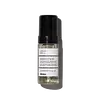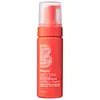What's inside
What's inside
 Key Ingredients
Key Ingredients

 Benefits
Benefits

 Concerns
Concerns

 Ingredients Side-by-side
Ingredients Side-by-side

Water
Skin ConditioningPolysorbate 20
EmulsifyingPropanediol
SolventParfum
MaskingAlcohol Denat.
Antimicrobial1,2-Hexanediol
Skin ConditioningCoco-Betaine
CleansingPolyquaternium-11
Disodium EDTA
Polyquaternium-53
Soy Amino Acids
Skin ConditioningWheat Amino Acids
Skin ConditioningCitric Acid
BufferingGlycine
BufferingLysine Hcl
Skin ConditioningPolyester-37
Skin ConditioningPvp
Emulsion StabilisingSodium Chloride
MaskingCaprylhydroxamic Acid
Arginine Hcl
Skin ConditioningSerine
MaskingThreonine
Polyacrylamidopropyltrimonium Chloride
Polyquaternium-55
Distearyldimonium Chloride
Phenoxyethanol
PreservativeBehentrimonium Chloride
PreservativeBenzyl Alcohol
PerfumingGamma-Docosalactone
Skin ConditioningAlpha-Isomethyl Ionone
PerfumingCaprylyl Glycol
EmollientGlycine Soja Sterols
EmollientWater, Polysorbate 20, Propanediol, Parfum, Alcohol Denat., 1,2-Hexanediol, Coco-Betaine, Polyquaternium-11, Disodium EDTA, Polyquaternium-53, Soy Amino Acids, Wheat Amino Acids, Citric Acid, Glycine, Lysine Hcl, Polyester-37, Pvp, Sodium Chloride, Caprylhydroxamic Acid, Arginine Hcl, Serine, Threonine, Polyacrylamidopropyltrimonium Chloride, Polyquaternium-55, Distearyldimonium Chloride, Phenoxyethanol, Behentrimonium Chloride, Benzyl Alcohol, Gamma-Docosalactone, Alpha-Isomethyl Ionone, Caprylyl Glycol, Glycine Soja Sterols
Water
Skin ConditioningDecyl Glucoside
CleansingGlycerin
HumectantVp/Va Copolymer
Pullulan
Prunus Domestica Seed Oil
Skin ConditioningSqualane
EmollientNiacinamide
SmoothingBiotin
AntiseborrhoeicFolic Acid
Skin ConditioningPolyglyceryl-3 Cocoate
EmulsifyingPolyglyceryl-4 Caprate
EmulsifyingHydrogenated Lecithin
EmulsifyingHelianthus Annuus Seed Oil
EmollientPolyglyceryl-6 Caprylate
EmulsifyingPolyglyceryl-6 Ricinoleate
EmulsifyingSodium Polyitaconate
Sucrose
HumectantCitric Acid
BufferingPanthenol
Skin ConditioningSodium Starch Octenylsuccinate
AbsorbentCalcium Pantothenate
Maltodextrin
AbsorbentSodium Ascorbyl Phosphate
AntioxidantPyridoxine Hcl
Skin ConditioningTocopheryl Acetate
AntioxidantCitrus Junos Peel Extract
Skin ConditioningSilica
AbrasiveParfum
MaskingDehydroacetic Acid
PreservativeBenzyl Alcohol
PerfumingWater, Decyl Glucoside, Glycerin, Vp/Va Copolymer, Pullulan, Prunus Domestica Seed Oil, Squalane, Niacinamide, Biotin, Folic Acid, Polyglyceryl-3 Cocoate, Polyglyceryl-4 Caprate, Hydrogenated Lecithin, Helianthus Annuus Seed Oil, Polyglyceryl-6 Caprylate, Polyglyceryl-6 Ricinoleate, Sodium Polyitaconate, Sucrose, Citric Acid, Panthenol, Sodium Starch Octenylsuccinate, Calcium Pantothenate, Maltodextrin, Sodium Ascorbyl Phosphate, Pyridoxine Hcl, Tocopheryl Acetate, Citrus Junos Peel Extract, Silica, Parfum, Dehydroacetic Acid, Benzyl Alcohol
Alternatives
Ingredients Explained
These ingredients are found in both products.
Ingredients higher up in an ingredient list are typically present in a larger amount.
Benzyl Alcohol is most commonly used as a preservative. It also has a subtle, sweet smell. Small amounts of Benzyl Alcohol is not irritating and safe to use in skincare products. Most Benzyl Alcohol is derived from fruits such as apricots.
Benzyl Alcohol has both antibacterial and antioxidant properties. These properties help lengthen the shelf life of products. Benzyl Alcohol is a solvent and helps dissolve other ingredients. It can also improve the texture and spreadability.
Alcohol comes in many different forms. Different types of alcohol will have different effects on skin. This ingredient is an astringent alcohol.
Using high concentrations of these alcohols are drying on the skin. They may strip away your skin's natural oils and even damage your skin barrier. Astringent alcohols may also irritate skin.
Other types of astringent alcohols include:
According to the National Rosacea Society based in the US, you should be mindful of products with these alcohols in the top half of ingredients.
Any type of sanitizing product will have high amounts of alcohol to help kill bacteria and viruses.
Learn more about Benzyl AlcoholCitric Acid is an alpha hydroxy acid (AHA) naturally found in citrus fruits like oranges, lemons, and limes.
Like other AHAs, citric acid can exfoliate skin by breaking down the bonds that hold dead skin cells together. This helps reveal smoother and brighter skin underneath.
However, this exfoliating effect only happens at high concentrations (20%) which can be hard to find in cosmetic products.
Due to this, citric acid is usually included in small amounts as a pH adjuster. This helps keep products slightly more acidic and compatible with skin's natural pH.
In skincare formulas, citric acid can:
While it can provide some skin benefits, research shows lactic acid and glycolic acid are generally more effective and less irritating exfoliants.
Most citric acid used in skincare today is made by fermenting sugars (usually from molasses). This synthetic version is identical to the natural citrus form but easier to stabilize and use in formulations.
Read more about some other popular AHA's here:
Learn more about Citric AcidParfum is a catch-all term for an ingredient or more that is used to give a scent to products.
Also called "fragrance", this ingredient can be a blend of hundreds of chemicals or plant oils. This means every product with "fragrance" or "parfum" in the ingredients list is a different mixture.
For instance, Habanolide is a proprietary trade name for a specific aroma chemical. When used as a fragrance ingredient in cosmetics, most aroma chemicals fall under the broad labeling category of “FRAGRANCE” or “PARFUM” according to EU and US regulations.
The term 'parfum' or 'fragrance' is not regulated in many countries. In many cases, it is up to the brand to define this term.
For instance, many brands choose to label themselves as "fragrance-free" because they are not using synthetic fragrances. However, their products may still contain ingredients such as essential oils that are considered a fragrance by INCI standards.
One example is Calendula flower extract. Calendula is an essential oil that still imparts a scent or 'fragrance'.
Depending on the blend, the ingredients in the mixture can cause allergies and sensitivities on the skin. Some ingredients that are known EU allergens include linalool and citronellol.
Parfum can also be used to mask or cover an unpleasant scent.
The bottom line is: not all fragrances/parfum/ingredients are created equally. If you are worried about fragrances, we recommend taking a closer look at an ingredient. And of course, we always recommend speaking with a professional.
Learn more about ParfumWater. It's the most common cosmetic ingredient of all. You'll usually see it at the top of ingredient lists, meaning that it makes up the largest part of the product.
So why is it so popular? Water most often acts as a solvent - this means that it helps dissolve other ingredients into the formulation.
You'll also recognize water as that liquid we all need to stay alive. If you see this, drink a glass of water. Stay hydrated!
Learn more about Water